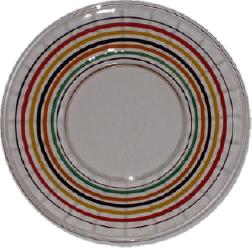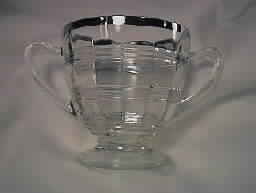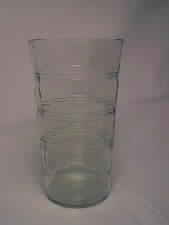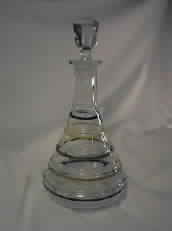National Depression Glass Association
Preserving America's Glass Manufacturing Heritage
Hocking's Ring Pattern
by Rosemary Trietsch
A few months back, a collector wrote to me with questions about the pattern he collects. Not being one to waste valuable research, I figured I'd share what I learned about Anchor Hocking's Ring pattern with all of you.
 Ring was
made by Hocking from 1927 to 1933. The company catalogs list it as
No. 1300 with no name, but in Colored Glassware of the Depression
Era, Book 2, Hazel Marie Weatherman shows a Hocking ad for the 10
piece cocktail set which reads, "Stylish Pattern ... Our famous
'Ring' design, known and appreciated everywhere for its
extraordinary brilliance and sparkle. Each piece is artistic and
graceful in shape." (Pg. 136) The colored bands found on Ring were
called "Decoration 21" by Hocking, but somewhere along the way,
collectors started using "Banded Ring" to distinguish the decorated
from the plain. Most people use the two names interchangeably
without any offense intended to serious collectors.
Ring was
made by Hocking from 1927 to 1933. The company catalogs list it as
No. 1300 with no name, but in Colored Glassware of the Depression
Era, Book 2, Hazel Marie Weatherman shows a Hocking ad for the 10
piece cocktail set which reads, "Stylish Pattern ... Our famous
'Ring' design, known and appreciated everywhere for its
extraordinary brilliance and sparkle. Each piece is artistic and
graceful in shape." (Pg. 136) The colored bands found on Ring were
called "Decoration 21" by Hocking, but somewhere along the way,
collectors started using "Banded Ring" to distinguish the decorated
from the plain. Most people use the two names interchangeably
without any offense intended to serious collectors.
You will find Ring primarily in transparent green, plain
crystal, crystal with silver trim, and crystal with colored bands.
A very few pieces were also made in pink, Royal Ruby and "Mayfair"
blue, but these colors were not marketed by Hocking. Rather, they
were produced as  special orders for other companies to use as premium items, but
judging from the amounts of these colors that exist today, the
promotions must not have gone over well. The silver trimmed pieces
tend to show wear as the silver was applied to the rims of plates,
cups, and tumblers where it's subjected to the most use. The
colored bands have proved more durable through the years, and come
in various combinations of black, yellow, red, orange and, more
rarely, blue and green. It's important to remember that colored
bands on a piece of glass do not make it Hocking's Ring pattern. To
truly be Ring, there must be molded bands of impressed ridges, or
rings, and a slight paneling in the glass, similar to Block
Optic.
special orders for other companies to use as premium items, but
judging from the amounts of these colors that exist today, the
promotions must not have gone over well. The silver trimmed pieces
tend to show wear as the silver was applied to the rims of plates,
cups, and tumblers where it's subjected to the most use. The
colored bands have proved more durable through the years, and come
in various combinations of black, yellow, red, orange and, more
rarely, blue and green. It's important to remember that colored
bands on a piece of glass do not make it Hocking's Ring pattern. To
truly be Ring, there must be molded bands of impressed ridges, or
rings, and a slight paneling in the glass, similar to Block
Optic.
Ring is a relatively small pattern compared to the others
Hocking was producing at the same time, and although it shares many
of the same shapes and handle designs as Cameo and Block Optic, it
hasn't nearly as many pieces available. There were no dinner
plates, butter dishes, or cream soup bowls made, and you won't find
a covered candy dish or jam jar in the Ring pattern. What is
interesting, however, is that there are pieces unique to the Ring
line that weren't made in these larger  patterns. For example, Ring has four
different shaped cocktail shakers. There is also a 6¼ inch
plate with an off-center ring that held a flat sherbet bowl.
Hocking didn't produce these pieces in any other pattern of the
time. The saucer has a cup ring, which is odd when you consider how
many of Hocking's other patterns used the 6-inch plate as
saucer/sherbet liner/bread and butter plate to save money. (If only
they had put more of these cup rings on Cameo sherbet plates
...)
patterns. For example, Ring has four
different shaped cocktail shakers. There is also a 6¼ inch
plate with an off-center ring that held a flat sherbet bowl.
Hocking didn't produce these pieces in any other pattern of the
time. The saucer has a cup ring, which is odd when you consider how
many of Hocking's other patterns used the 6-inch plate as
saucer/sherbet liner/bread and butter plate to save money. (If only
they had put more of these cup rings on Cameo sherbet plates
...)
Hocking seemed to be focusing the production and marketing of
its Ring line in the area of casual entertaining. The catalog
listings show that is was often sold in pre-packaged sets that were
perfect for Bridge parties, afternoon luncheons, or evening
cocktail parties. There were two 10-piece cocktail sets sold,
consisting of a shaker, ice bucket and 8 low tumblers, or a shaker,
11-inch plate and 8 tall stemmed cocktail glasses, perhaps for more
formal occasions. There was a Coffee set with 4 cups & saucers,
a sugar and a creamer. The Beverage set included a pitcher and 8
tumblers, while the Iced Tea/Sandwich set had a pitcher, footed
tumblers, ice bucket and the center-handled sandwich tray. The 17
piece Luncheon set is interesting in that along with 8-inch plates,
footed tumblers, and the center-handled server, it included tall
sherbets and 6-inch sherbet plates instead of cups & saucers.
By including this sherbet set instead of cups & saucers,
Hocking added a bit of elegance to an otherwise ordinary  service for 4. Once
again, marketing aimed at capturing the elegance of the more
prosperous 1920's succeeded in selling glass during the
Depression.
service for 4. Once
again, marketing aimed at capturing the elegance of the more
prosperous 1920's succeeded in selling glass during the
Depression.
One of the nicest things about the Ring pattern is the way it blends in with whatever you're using, whether it's cobalt Moderntone or Lenox china. The stemware is graceful and really does have " ... extraordinary brilliance and sparkle." Add the pitcher and ice bucket, and you've got a lovely beverage service. If you collect the decorated Ring pieces, there's lots of glass that was produced during the same time period with similar colored bands and decorations. In fact, the most beautiful collection of Banded Ring I've ever seen belongs to a man who purchased the decorated ice bucket and decanter from me to use with his Fiesta collection. He showed me pictures of the open shelves in his kitchen where he stores his dishes and glasses, and the combination of colors was amazing. If more Fiesta collectors discover this wonderful combination of pottery and Depression glass, there may be no decorated Ring pieces left for us Depression glass collectors. Then again, I may have just created a bunch of new Fiesta collectors ...
Webmaster's Note: The author is an NDGA Board member, dealer, collector and co-owner of JustGlass.com, a web site with a host of information pertaining to glass as well as glass for sale. We thank Rosemary for permission to reproduce her article.